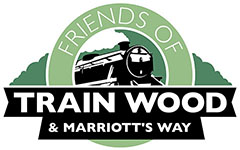Did you know there were 20 different kinds of buttercup? Me neither. But thanks to Norfolk Wildlife Trust’s Gemma Walker, the Train Wood plant hunters do now.
On Sunday morning she came out bright and early with us on our first ever plant survey. We bumped into all sorts of people (as you do in Train Wood) – from the former senior curator of Natural History at Norwich Museum, Dr Tony Irwin, who wished us well – to a guerrilla conservationist, who we discovered (somewhat to her displeasure) deep in a hitherto unexplored area of the wood, clearing brambles alone and in secret. She wishes to remain nameless, and we wish her well in her task.
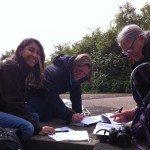
Christina, Gemma and Tish get down to surveying the Marriott’s Way
Many families, dog walkers, cyclists and runners also stopped and said hello to the four of us, and our number grew as family and friends joined in.
But back to the plants. There were hundreds. It was hard to get round the wood when you had to keep stopping to poke, prod and wonder; and identifying them soon became interesting, then a bit addictive.
Gemma had a tale to tell about many. Like Herb Robert, so named by an enemy of the said Robert because it is rather smelly. Or Fireweed, aka Rose Bay Willow Herb, often found near train stations. Or Hemlock, which Socrates was forced to drink one teaspoonful of, to put him to death (there is a patch just by the Marriott’s Way, so beware).
Identifying can be straightforward or it can be tricky. In the case of our special buttercup, it is easy – it has downward-pointing sepals (the bits under the petals) – which makes it a rather special Bulbous Buttercup. I did take a picture, but it blazed so golden in the sunlight that of all the shots, it was blurred.
It was fascinating to find so many currants and berries in the wood – red, white and black currant, and raspberries along the bank of the river – as well as brambles everywhere, and appleblossom too. This place used to be partly allotments, which might explain it – but Gemma mentioned that redcurrant is also a native plant of wet woodland.
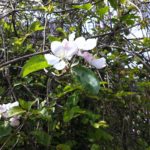
Apple blossom
Plants are of course the basis of life, and there was plenty of wildlife in the wood as well. We were serenaded by Black caps, Blackbirds and a Song thrush; a Stock Dove purred its gentle hoots, and then wood pigeon joined in. A robin followed us for a bit, and we saw a moorhen sitting on its nest, artfully constructed in tree branches overhanging but not in the water. When the babies hatch, they jump out of the nest straight in to the river.
Everywhere, insects were after the first nectar – a male orange tip butterfly, sunning itself and revealing its amazing patterned underwings (it lays its eggs on garlic mustard, which we also saw); a red tailed bumble bee and a bee fly (yes indeed, a fly that looks like a bee). It was great to share the sharp eyes and experience of the group. I never would have noticed the ‘Thrushes anvil’ – yellow and brown snail shells broken open on a hard spot where the increasingly rare bird brings its dinner to crack open.
At a conservative estimate, we counted about a hundred species of plant. As Train Wood’s very own Community Wildlife Surveyors, we’ll be listing and counting plants every month this summer, mapping all our findings with the help of Norfolk Wildlife Trust, funded by the Heritage Lottery Fund. The results will be used to protect and enhance this wonderful wild wet and dry woodland, a nature oasis in the city. Do come and join us – and pop along to our BioBlitz on May 27th too.
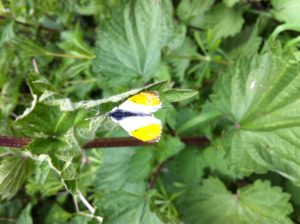
Orange Tip Butterfly
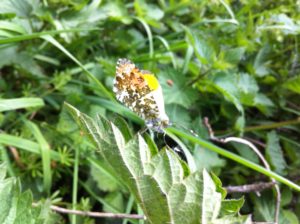
Under wings of orange tip, ready for quick camouflage
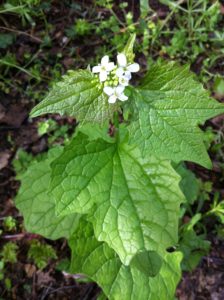
Garlic mustard, where the Orange tip lays its eggs. An amazing smell of garlic when the leaf is torn.
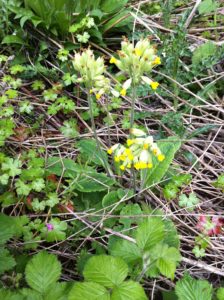
Cowslips by the engine shed

